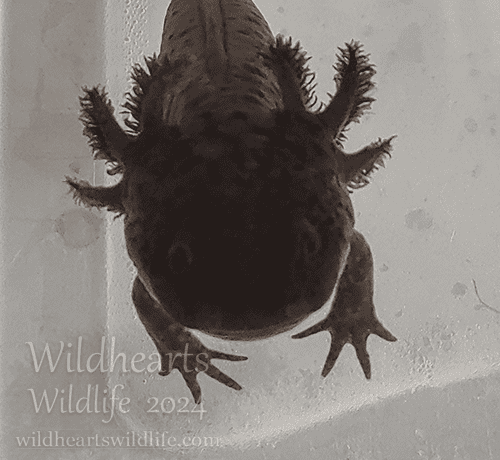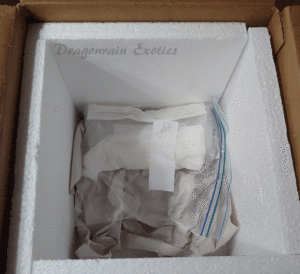Moving can be an exciting experience but, I think, most everyone knows that, even in the best of situations, moving can also be really stressful. Add a whole gaggle of pets into the mix and suddenly you’re on a whole other level. You don’t just have to worry about packing, and finances, and all the normal stuff associated with a move, but you have to worry about your animal family members too. How do you move them all safely? How do you move their enclosures? Is the move going to cause them stress? Could the high stress make them sick?

Some animals are easier to move than others.
In some cases, how well an animal takes a move can just come down to each individual’s personality. For some, a move is easy to take in stride, and it won’t cause a lot of excess stress. When it comes to exotic pets, I’ve found this to be especially true if you’re able to move their current enclosure intact so, after a move, they don’t have to get used to a new setup.
With axolotls, the fact that they’re aquatic adds an extra layer of complexity. It’s not like you can stick a fully set-up aquarium into your car and move it across the country. Axolotls, depending on the individual, can also be susceptible to developing illness if they get overly stressed. They are also temperature sensitive, preferring cool water, which can add another layer of difficulty to moving them, especially long distances.
So how can you safely move your axolotl and their aquarium?
A few years ago my partner and I moved. At the time, we had two axolotls – Bubbles and Gilly. Out of all my exotic pets, I was most stressed about moving the axolotls. Thankfully, with a little bit of prep work, the move went well and everyone made it to our new house safe and sound – axolotls included. This is how I moved with my axolotls, although it’s not the only way you can do it.
Moving Axolotls
No, the seemingly random link to an article I wrote about how to ship axolotls is not actually random at all!
This is because I moved my personal pet axolotls in a very similar way to how a breeder would ship one. It makes sense right? When shipping an axolotl, you have to ensure they’ll remain safe in transit, even if they are shipped in weather that isn’t 100% ideal, with shippers who may not be as careful as we’d like, in bouncy old delivery trucks. If the shipping methods breeders use routinely keep axolotls safe while they’re being shipped, it makes sense the same techniques would work to transport them from one house to another. Especially when you keep in mind that you’re likely going to treat your axolotl with a lot more care than UPS or FedEx commonly would!

When I moved with Bubbles and Gilly, I used fish shipping bags to contain them. Similar to how a breeder would pack an axolotl to be shipped, I filled the bags with about 1/4th water and 3/4ths air. You want your axolotl to have enough water to cover them, but air to breathe is actually more important. I tied the bags shut. If you’re traveling long distances or worried about the fish bags leaking, you can double bag your axolotl.
At first glance it may seem cruel to confine your axolotl inside a bag and hey, I get it. But during a move, keeping our gilled friends safe is most important. Fish shipping bags are designed for transporting aquatic animals. The bags are soft plastic, so even if your axolotl gets tossed around a bit during your drive you shouldn’t have to worry too much. The sides of the bag are soft and smooth.

Once your axolotl is contained, you’re going to want to place them, inside their bag, into an insulated container. You can use a box lined with Styrofoam, similar, again, to how axolotls are shipped. But if you don’t have an insulated box, a cooler will work just as well!
I recommend sticking ice packs inside your insulated container as well. More often than not, you’re going to have to worry a lot more about your axolotl overheating than about them getting too cold, especially while traveling.
Moving Your Axolotls Aquarium
When axolotl owners ask me for tips on moving with their axolotls, they’re typically more concerned about moving their axolotl’s home than the axolotls themselves! It makes sense. Most people can put their axolotl in some type of container and move them, but the thought of moving an entire aquatic ecosystem is daunting.
The important thing to keep in mind is that the beneficial bacteria that works to keep your axolotl’s tank cycled mostly live inside your filter. Some may live on other surfaces, such as on sand, if you use it, and on other objects such as decor and plants. Your beneficial bacteria doesn’t live in the water column, so you don’t have to worry about transporting old tank water with you when you move!
What you do have to do, however, if you want to preserve your aquarium’s cycle, is is transport your filter, and some surfaces if you can, in a way that will allow your beneficial bacteria to survive the move. This will typically mean transporting your filter inside some tank water, because allowing your filter media to dry out will kill off your bacteria colony.
When I moved with my axolotls, I wasn’t as careful with my filter/aquarium surfaces as I was with my axolotls. I bought a few 5lb buckets with lids at my local hardware store, and filled them up with enough aquarium water that I could transport my filter, and some other aquarium surfaces like my sand and live plants, inside the bucket of water.
Basically, don’t allow your filter to dry out during your move! It’s a good idea to protect it from temperature extremes as well.
If you’re moving further away or don’t have space to transport buckets, you can transport some of your filter media inside a fish bag with water in it, similar to how I recommended you transport your axolotl!
Set Up Your Aquarium ASAP
I know, moving is SO much work! You’ll have so much to do to get settled in once you get to your new place. It’s important, however, to get your axolotl comfortable in your new place ASAP. If you can, set up your aquarium again right away. The less time your filter/filter media spends in a temporary container, the more likely it will be that more of your beneficial bacteria colony survives!
It’s a good idea to tub your axolotl for at least a few days after setting up your aquarium, so you can ensure enough of your beneficial bacteria survived the journey to maintain your tank’s cycle.
Have You Ever Moved With An Axolotl?
Thankfully, using the techniques I wrote about here, I was able to successfully move with my two axolotls. When I eventually move again, this time with double the axolotls, I’ll use the same methods. They should work well, whether you’re just moving across town or across the country! Keep in mind that breeders ship axolotls all the time, and shipping companies are likely not as careful as owners will be with their own pets. So, we can take a cue from sellers and pack our axolotls similar to how a breeder would ship them to keep them safe during car rides.
You don’t have to worry about transporting old tank water, which makes things a bit easier, but be careful not to allow your filter to dry out if you want to attempt to maintain your aquarium’s already established cycle. Even if you transport your filter in water, always make sure to check your aquarium’s parameters to ensure it is still cycled after a move. Sometimes, events outside of our control, such as temperature spikes or delays during transport, can kill off significant numbers of beneficial bacteria. Tubbing your axolotl for awhile is ok if you need time to reset up, or recycle, their tank after a move.
Have you ever moved with an axolotl, or are you planning too soon? With a bit of preparation, thankfully, moving safely with axolotls isn’t too complicated. Your axolotl will surely appreciate you bringing them with you!
———————
Unfortunately, Wild Hearts Wild Life has been dealing with content scrappers stealing our content and posting it to other websites without permission. If you’re seeing this article posted anywhere besides wildheartswildlife.com it means you are seeing it on a content scalper’s site. Please consider contacting us to let us know, and stopping by to visit on our actual site! Thank you!
